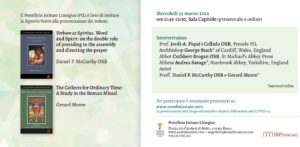Watch the video of the presentation of two books at the Pontifical Athenaeum Sant’Anselmo on 23 March 2022. Photos of the event soon will be available here on Flickr.
Dr Gerard Moore presented the second edition of his study on the “collects”, or opening prayers of the Mass, titled: Vatican II and the Collects of Ordinary Time. He is the principal of the Australian Institute of Theological Education. Book description.
Fr. Daniel McCarthy, OSB, presented principles for arranging a church for the celebration of liturgy, titled Word and Spirit: On the double role of presiding in the assembly and directing the prayer. He is lecturer at the Pontifical Institute of Liturgy at Sant’Anselmo. Book description.
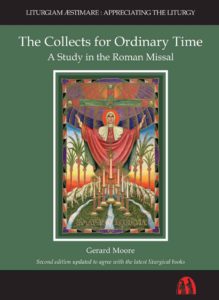 The video begins part way through the presentatation.
The video begins part way through the presentatation.
Not recorded were:
Welcome by the Preside Jordi
Presentation by Archbishop George Stack
Most of the presentation by Abbot Cuthbert Brogan (text below)
1:00 minute: Mother Andrea Savage, Stanbrook Abbey spoke online from the UK.
11:20 minute: Dr Gerard Moore speaks on his volume online from Australia
19:12 minute: Fr. Daniel McCarthy expresses his gratitude (text at the bottom of this page)
26:04 minute: Archbishop Arthur Roche, Prefect of the Congregation of Divine Worship and the Discipline of the Sacraments.
30:14 minute:conclusion
You may watch the video embeded above or at this link.
Booth books are part of the series Liturgiam aestimare : Appreciating Liturgy, a series of DREI Publishing described at this link.
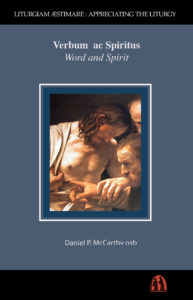 Archbishop Arthur Roche (Italian version) spoke of the importance of both studies and personally addressed those present. He is the prefect of the Vatican Congregation for Divine Worship and the Discipline of the Sacraments.
Archbishop Arthur Roche (Italian version) spoke of the importance of both studies and personally addressed those present. He is the prefect of the Vatican Congregation for Divine Worship and the Discipline of the Sacraments.
Archbishop George Stack (Italian version) also spoke online from his diocese of Cardiff in Wales.
Abbess Andrea Savage of Stanbrook Abbey in North Yorkshire, England, spoke about the arrangement of their new Abbey Church designed using the principles given in the book Word and Spirit.
Abbot Cuthbert Brogan of St Michael’s Abbey in Farnborough, Hampshire, England, published the two volumes and spoke about the history of the academic contributions of Farnborough Abbey. You may read his presentation below.
Fr. Daniel McCarthy expressed his gratitude to all who attended and helped in the writing and publication of the two volumes. You may read his expression of thanks at the bottom of this web-page.
The event was moderated by the president of the Pontifical Institute of Liturgy, Prof. Jordi-A. Piqué i Collado OSB.
Descriptions and purchasing information for the two volumes
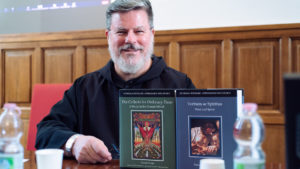 Vatican II and the Collects of Ordinary Time
Vatican II and the Collects of Ordinary Time
Book description: Liturgy Institute
In the UK: Purchase from The Abbey Shop
In the USA: Purchase from CUA Press.
In Rome: Purchase from Paoline Multimedia, Via del Mascherino, 94
Also available from your local Amazon web site.
Daniel McCarthy: Word and Spirit
Book description: Liturgy Institute
In the UK: Purchase from The Abbey Shop
In the USA: Purchase from CUA Press
In Rome: Purchase from Paoline Multimedia, Via del Mascherino, 94
Also available from your local Amazon web site.
Presentation by Abbot Cuthbert Brogan of St. Michael’s Abbey, Farnborough, UK
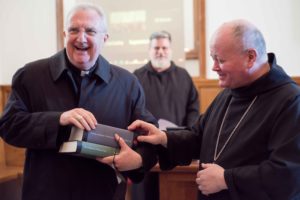 Whenever I have reason to type ‘Solesmes’ into my computer, the spellcheck rejects it and offers ‘salesmen’ as an alternative!
Whenever I have reason to type ‘Solesmes’ into my computer, the spellcheck rejects it and offers ‘salesmen’ as an alternative!
I suppose the spellcheck understands my two roles here today – firstly as a seller of printed papers from the St Michael’s Abbey Press, but most importantly as the guardian of a tradition of liturgical publishing which goes back to the origins of my monastery.
In 1880 the Empress Eugénie of France moved to Farnborough and built our Abbey as the Imperial Mausoleum of her husband Napoleon II and their son the Prince Imperial. By 1895 she was looking for a community to man the foundation, and turned to the monks of the French Abbey of St Pierre de Solesmes. At Solesmes the Prior, Dom Cabrol, had asked Abbot Delatte about the possibility of a new monastery dedicated to studies. But in the midst of the political vicissitudes of France, Delatte was opposed. Where would such a community live? How would it be financed? What would they eat?
The Empress’ arrival seemed providential. She offered a house outside of France, a generous benefactress, and a monastery with two train stations in walking distance. One which could take you to the British Museum Reading Room, now the British Library, and another which could get you to Oxford in just over an hour and to the resources of the Bodleian. And so the first Benedictines were installed at Farnborough in December 1895.
By the time of the Frist World War most of the monks were internationally renowned scholars. Dom André Wilmart on medieval spirituality, Dom Ferotin on Spanish topics, Dom Cottineau on the history of the monastic Order, Dom Louis Gougaud on Celtic liturgies, Dom Baudot on the history of the Roman Breviary, to name but a few. The text of Egeria, known then as the Peregrinatio Etheriae, was examined and authenticated at Farnborough, and the works of these individual giants were joined by the Dictionnaire d’archéologie chrétienne et de liturgie. Dom Henri Leclerq’s output was legendary and earned for Farnborough the nickname of the ‘book factory’.
Abbot Cabrol insisted that the community should not confine itself to high studies. He spoke of the vulgurisation of the liturgy. By this he did not intend any ‘dumbing down’, but this was his preferred word to describe the work of making the liturgy more immediate and accessible to all. He loved the Missale Romanumand, as his obituary in the Buckfast Chronicle records, was never so happy as when at the altar. Various books were published to this end and his Cabrol Missal and his Mon Missel made him a household name.
Farnborough thus became a Liturgical Movement house. Its guest book is a litany of liturgical greats: Columba Marmion, Vonier, Beauduin, Bishop, amongst them. It was a massive contribution but it remains relatively unknown that the bulk of liturgical studies of the then Congregation de France, in fact took place in Hampshire. Indeed the English language would only intrude on Farnborough’s life in 1940, when it was introduced on Mondays and Tuesdays, ad experimentum! Fine translations of many of Farnborough French works were prepared by the nuns of Stanbrook. Their participation in today’s presentation is a particular delight!
Farnborough’s contribution to the Liturgical Movement was vastly important. But it was a truly Benedictine, hidden, and discreet, work of long labour in libraries.
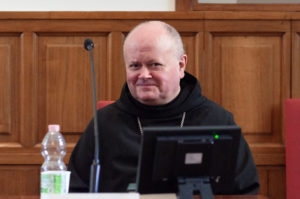 Today the community is young and active. Its today is well-rooted in its yesterday, in the theoria and praxis of the Sacred Liturgy, as well as in publishing. This has recently included translating works of Dom Guéranger and of Dom Lambert Beauduin. Mediator Dei and Sacrosanctum Concilium likewise have been issued by the St Michael’s Abbey Press with a helpful essay by Aidan Nicholls OP. The two volumes we launch today is a reminder that the Liturgical Movement is alive and active.
Today the community is young and active. Its today is well-rooted in its yesterday, in the theoria and praxis of the Sacred Liturgy, as well as in publishing. This has recently included translating works of Dom Guéranger and of Dom Lambert Beauduin. Mediator Dei and Sacrosanctum Concilium likewise have been issued by the St Michael’s Abbey Press with a helpful essay by Aidan Nicholls OP. The two volumes we launch today is a reminder that the Liturgical Movement is alive and active.
The St Michael’s Abbey Press enjoys a fine reputation for the quality of its publications. Not for us ‘print on demand’ or ‘perfect’ binding. Our volumes are sewn and hardbound and are reasonably priced. We aspire to a high standard of typesetting and production, for which we must thank Dom Stanislaus who is present today. Dom Gregory Carey of Farnborough must also be congratulated on the mammoth task of editing Gerard Moore’s mighty work. We value highly our collaboration with the Pontifical Liturgical Institute of Sant Anselmo and the Institutum Liturgicum of England and Wales.
The late Dom James Leachman spoke often of an ‘eirenic’ approach to the liturgy. Non in comotione Deus. The very mention of ‘liturgy’ today is often a declaration of war, but this holds no interest for us. The pax of the daily round of the monastic day has long been a fruitful environment for study.
We offer these volumes in humble service to the Church, to help equip clergy, laity, students, and teachers to love the riches of our liturgical tradition and to love the Missal as so wonderfully examined in Gerard Moore’s work and the liturgical environment as so eloquently described by Fr Daniel.
+Dom Cuthbert Brogan OSB
Expression of appreciation by Fr. Daniel McCarthy, OSB
At a fateful Sunday buffet dinner here at Sant’Anselmo — was it in 2007? — Prof. James Leachman and I told then Br. Maximilian that we needed somewhere to publish a book. That evening, Abbot Cuthbert, you welcomed us to publish with you, and so now you have joined us here to celebrate your publication of the third and fourth volumes. We have ever been grateful for your personal and continuing support both of our writing and of the Liturgy Institute.
We immediately saw the great value in the first edition of this work by Dr Gerard Moore, as did Abbot Cuthbert who offered to publish an updated version with the help of Dom Gregory. I’m grateful for your trust in us Gerard to bring this project to completion and for the collaboration that has developed among us.
At a meeting of formators held at Ealing Abbey, I knew that I had only 60 seconds to inspire Sr. Laurentia Johns with the beauty of an ambo. It worked and Mother Andrea invited James and me to discuss the plans for the interior arrangement of their new church. After the transfer of the Stanbrook community and dedication of the new monastery and chapel, Mother Andrea wrote a Testimonium which begins this volume and the volume concludes with my Laudatio of their new abbey church. Now as a capstone, we are grateful, you, Mother Andrea, have come to share with us your joy.
Archbishop George Stack presented plans for renovating the cathedral in Cardiff, Wales, during his St. Bede Lecture at Ealing Abbey in 2017. He held discussion sessions with parishioners and staff where they considered the chapters of our volume, Come into the Light, articles James and I wrote for The Tablet of London developed from the insights of our professor emeritus Crispino Valenziano. Now the Archbishop has written a prologue for this volume which finds its culmination now in its presentation. We remain grateful for your continuing support of our writing and teaching Liturgy in London.
Fr. Ephrem Carr encouraged James and me to begin teaching Liturgy courses of the PIL in summer, in London, in English. With the endorsement of the Preside’s council we began teaching in 2011. We are grateful to have received ever since the endorsement of your council, Preside Jordi. I have but these results of our endeavours to show as a sign of our gratitude for your supporting our writing and teaching Liturgy in London.
When I arrived in Rome at the close of the last millennium, I began studying Latin all over from the beginning with Fr. Reginaldus Foster. Little did I know that now, some 23 years later I would be carrying on his legacy and even after his passing on Christmas day 2021 that I would be publishing our remaining volumes together. With great patience expressed sometimes as desperation he corrected my translations of countless Latin passages from the speeches made during the Second Vatican Council, during the preparation for the council and its subsequent renewal of the liturgy. In his absence I have but to continue our work as a sign of gratitude.
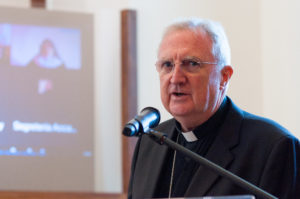 The St. Bede Lecture was given in 2012 by Archbishop Arthur Roche who spoke on the earthly liturgy as a foretaste of the heavenly. You welcomed James and me to your residence in Leeds, and you are well known to our friends at Stanbrook Abbey. In heartfelt gratitude for your ongoing support and presence here today we have only to offer our teaching and writing in service to the church.
The St. Bede Lecture was given in 2012 by Archbishop Arthur Roche who spoke on the earthly liturgy as a foretaste of the heavenly. You welcomed James and me to your residence in Leeds, and you are well known to our friends at Stanbrook Abbey. In heartfelt gratitude for your ongoing support and presence here today we have only to offer our teaching and writing in service to the church.
Sometimes a brisk walk can free the mind for insight. James had told me of the teaching by Irenaeus of Lyon, that God created the world with two hands: the Word and the Spirit. After a brisk walk with James one evening, the final exertion of coming up the steep incline of the Aventine hill in Rome, the insight came to connect the two hands of Word and Spirit to the two hands of Christ in the painting by Caravaggio featured on the cover of my volume and these to the two presidential offices of presiding in the liturgy and directing the prayer.
When James Leachman passed from this life, he held on to the hope and the promise that we who have been so inspired by him together might continue this important work to make the world a better place.
Thank you.
The following photo is of Archbishop Arthur Roche, Fr. Daniel McCarthy and about half of his Latin students of the Pontifical Institute of Liturgy, Sant’Anselmo, Rome.
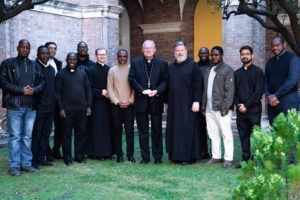
The following is the advetisement developed for the occasion.
